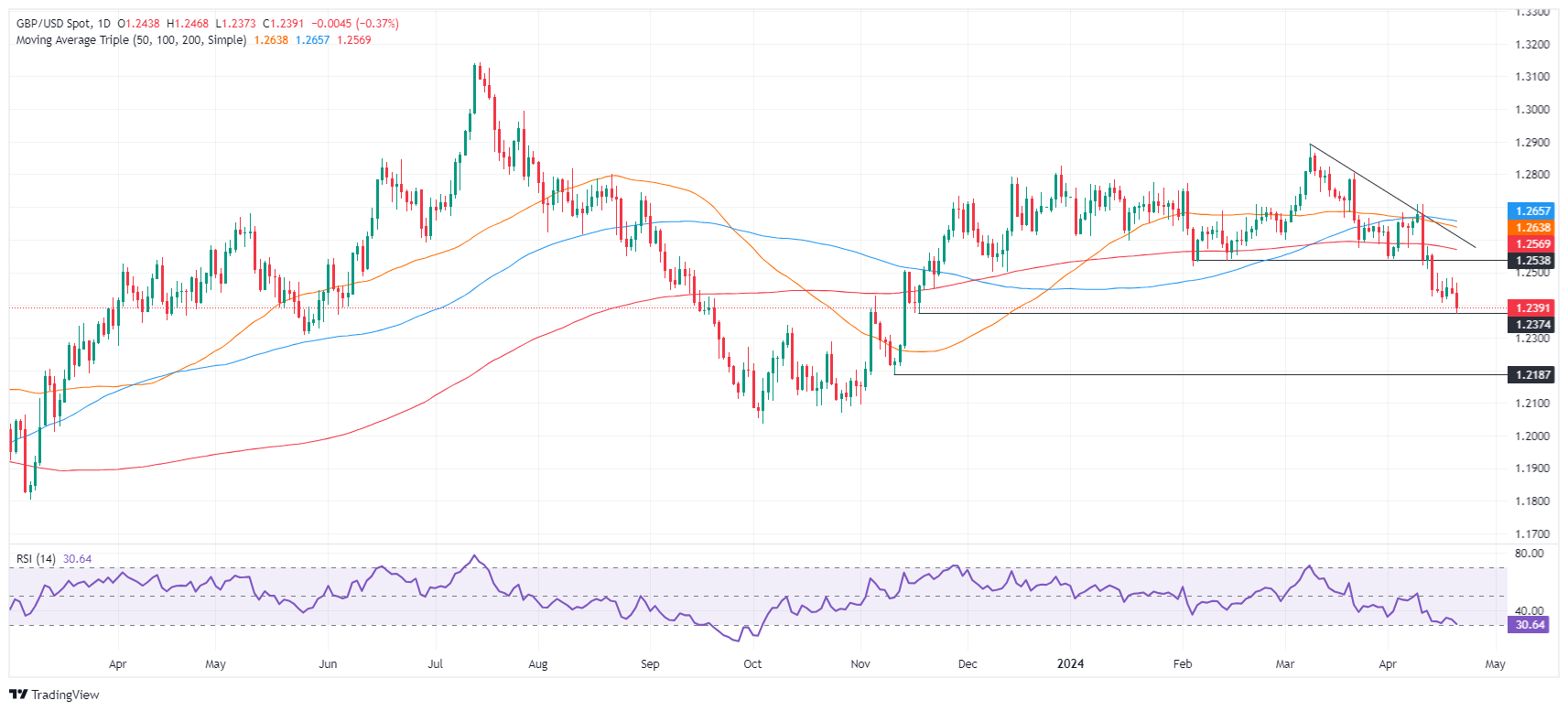- The GBP/USD pair falls 0.48% to 1.2376, influenced by increasing geopolitical risks and statements from major central banks.
- The Bank of England's deputy governor's comments on inflation risks fail to support the pound sterling, which is setting new lows.
- Mixed economic data in the UK, with retail sales stagnating in March, contrasting with modest annual growth.
The British pound falls against the US dollar during the North American mid-session after a volatile day due to the escalation of the conflict between Israel and Iran. Keynote speakers from central banks, led by the Bank of England (BoE) and the Federal Reserve (Fed), continued to set the tone for financial markets. The GBP/USD pair is trading at 1.2376, down 0.48%.
GBP/USD yields as the conflict between Israel and Iran escalates
According to Reuters, explosions occurred over an Iranian city on Friday, in what sources described as an attack by Israel. However, Iranian authorities downplayed the event and stated that they had no plans to retaliate. As a result, the GBP/USD pair fell towards 1.2388, a new five-month low, before regaining some ground.
The words of the BoE deputy governor, Dave Ramsden, failed to support the cable, which again hit five-month lows at 1.2372. Ramsden said he would consider the implications of Forex for inflation, adding that the bank would do what made sense in terms of the BoE's mandate. He added that the disinflation process would be bumpy, but that the risks lean to the downside.
On the other hand, Chicago Fed President Austan Goolsbee adopted a neutral stance, which boosted the dollar slightly. He commented that inflation progress has stalled, suggesting that a pause would allow incoming data to inform the disinflation process.
British retail sales showed signs of stagnation during the March European session compared to the February reading. Analysts were expecting 0.3% monthly sales growth, which came in at 0%, while underlying sales fell from 0.3% to -0.3%. On an annual basis, the Office for National Statistics (ONS) revealed that sales rose by 0.8%, up from -0.3% in February.
GBP/USD Price Analysis: Technical Outlook
After falling below 1.2400, the GBP/USD pair could resume its downtrend. Unless buyers reclaim the 1.2400 mark, sellers are in charge. The first support would be the November 17 low at 1.2373, followed by the November 10 low at 1.2187. On the other hand, if buyers reclaim 1.24000, the next key resistance zone would be the April 18 high at 1.2484, before 1.2500.

GBP/USD
| Overview | |
|---|---|
| Latest price today | 1,239 |
| Daily change today | -0.0047 |
| Today's daily variation | -0.38 |
| Today's daily opening | 1.2437 |
| Trends | |
|---|---|
| daily SMA20 | 1.2573 |
| 50 daily SMA | 1.2643 |
| SMA100 daily | 1,266 |
| SMA200 Journal | 1.2573 |
| Levels | |
|---|---|
| Previous daily high | 1.2485 |
| Previous daily low | 1.2434 |
| Previous weekly high | 1.2709 |
| Previous weekly low | 1.2427 |
| Previous Monthly High | 1.2894 |
| Previous monthly low | 1.2575 |
| Daily Fibonacci 38.2 | 1.2453 |
| Fibonacci 61.8% daily | 1.2465 |
| Daily Pivot Point S1 | 1.2419 |
| Daily Pivot Point S2 | 1.24 |
| Daily Pivot Point S3 | 1.2367 |
| Daily Pivot Point R1 | 1,247 |
| Daily Pivot Point R2 | 1.2503 |
| Daily Pivot Point R3 | 1.2521 |
Source: Fx Street
I am Joshua Winder, a senior-level journalist and editor at World Stock Market. I specialize in covering news related to the stock market and economic trends. With more than 8 years of experience in this field, I have become an expert in financial reporting.







